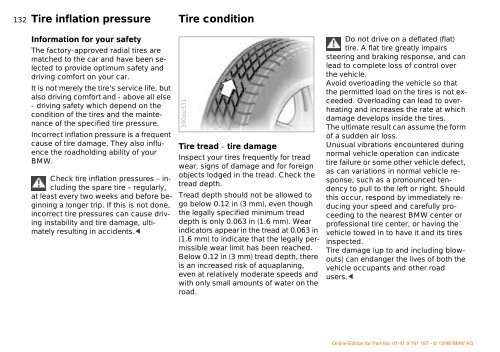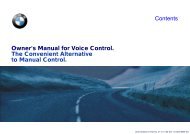Owner's Manual for the vehicle. With a quick reference ... - E38.org
Owner's Manual for the vehicle. With a quick reference ... - E38.org
Owner's Manual for the vehicle. With a quick reference ... - E38.org
Create successful ePaper yourself
Turn your PDF publications into a flip-book with our unique Google optimized e-Paper software.
132nTire inflation pressure<br />
Tire condition<br />
In<strong>for</strong>mation <strong>for</strong> your safety<br />
The factory-approved radial tires are<br />
matched to <strong>the</strong> car and have been selected<br />
to provide optimum safety and<br />
driving com<strong>for</strong>t on your car.<br />
It is not merely <strong>the</strong> tire's service life, but<br />
also driving com<strong>for</strong>t and - above all else<br />
- driving safety which depend on <strong>the</strong><br />
condition of <strong>the</strong> tires and <strong>the</strong> maintenance<br />
of <strong>the</strong> specified tire pressure.<br />
Incorrect inflation pressure is a frequent<br />
cause of tire damage. They also influence<br />
<strong>the</strong> roadholding ability of your<br />
BMW.<br />
Check tire inflation pressures – including<br />
<strong>the</strong> spare tire – regularly,<br />
at least every two weeks and be<strong>for</strong>e beginning<br />
a longer trip. If this is not done,<br />
incorrect tire pressures can cause driving<br />
instability and tire damage, ultimately<br />
resulting in accidents.<<br />
390de331<br />
Tire tread – tire damage<br />
Inspect your tires frequently <strong>for</strong> tread<br />
wear, signs of damage and <strong>for</strong> <strong>for</strong>eign<br />
objects lodged in <strong>the</strong> tread. Check <strong>the</strong><br />
tread depth.<br />
Tread depth should not be allowed to<br />
go below 0.12 in (3 mm), even though<br />
<strong>the</strong> legally specified minimum tread<br />
depth is only 0.063 in (1.6 mm). Wear<br />
indicators appear in <strong>the</strong> tread at 0.063 in<br />
(1.6 mm) to indicate that <strong>the</strong> legally permissible<br />
wear limit has been reached.<br />
Below 0.12 in (3 mm) tread depth, <strong>the</strong>re<br />
is an increased risk of aquaplaning,<br />
even at relatively moderate speeds and<br />
with only small amounts of water on <strong>the</strong><br />
road.<br />
Do not drive on a deflated (flat)<br />
tire. A flat tire greatly impairs<br />
steering and braking response, and can<br />
lead to complete loss of control over<br />
<strong>the</strong> <strong>vehicle</strong>.<br />
Avoid overloading <strong>the</strong> <strong>vehicle</strong> so that<br />
<strong>the</strong> permitted load on <strong>the</strong> tires is not exceeded.<br />
Overloading can lead to overheating<br />
and increases <strong>the</strong> rate at which<br />
damage develops inside <strong>the</strong> tires.<br />
The ultimate result can assume <strong>the</strong> <strong>for</strong>m<br />
of a sudden air loss.<br />
Unusual vibrations encountered during<br />
normal <strong>vehicle</strong> operation can indicate<br />
tire failure or some o<strong>the</strong>r <strong>vehicle</strong> defect,<br />
as can variations in normal <strong>vehicle</strong> response,<br />
such as a pronounced tendency<br />
to pull to <strong>the</strong> left or right. Should<br />
this occur, respond by immediately reducing<br />
your speed and carefully proceeding<br />
to <strong>the</strong> nearest BMW center or<br />
professional tire center, or having <strong>the</strong><br />
<strong>vehicle</strong> towed in to have it and its tires<br />
inspected.<br />
Tire damage (up to and including blowouts)<br />
can endanger <strong>the</strong> lives of both <strong>the</strong><br />
<strong>vehicle</strong> occupants and o<strong>the</strong>r road<br />
users.



